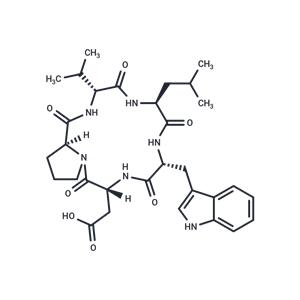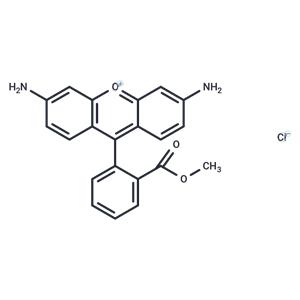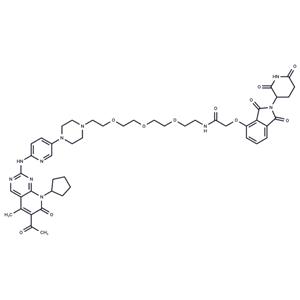
Dihydrorhodamine 123 NEW
| Price | $59 | $96 | $143 |
| Package | 1mg | 5mg | 10mg |
| Min. Order: | |
| Supply Ability: | 10g |
| Update Time: | 2025-07-16 |
Product Details
| Product Name: Dihydrorhodamine 123 | CAS No.: 109244-58-8 |
| Purity: 99.53% | Supply Ability: 10g |
| Release date: 2025/07/16 |
Product Introduction
Bioactivity
| Name | Dihydrorhodamine 123 |
| Description | Dihydrorhodamine 123 (DHR 123) is a fluorescent probe with excitation (λex=488 nm) and emission (λem=525 nm) wavelengths. |
| Cell Research | I. Detection of Reactive Oxygen Species (ROS) 1. Solution preparation: Dissolve DHR 123 in an appropriate solvent (such as DMSO or PBS) at a concentration of typically 1-10 μM. 2. Cell staining: Add DHR 123 solution to cultured cells and incubate at 37°C for typically 30-60 min. 3. Oxidation process: ROS produced in cells oxidize DHR 123, converting it into fluorescent products. 4. Fluorescence measurement: After staining, measure the fluorescence of the oxidation products using a fluorescence spectrophotometer or fluorescence microscope with an excitation wavelength of 488 nm and an emission wavelength of 525 nm. 5. Analysis: Analyze ROS levels in cells by fluorescence intensity. Experiments can be performed in real time or at fixed time points. II. Assessment of mitochondrial function and membrane potential 1. Cell incubation: Incubate cells as described above. 2. Mitochondrial ROS detection: Oxidized DHR 123 will show a fluorescent signal under a fluorescence microscope, indicating the generation of mitochondrial ROS. 3. Fluorescence microscopy observation: Observe the fluorescent signal to see the distribution of ROS in specific areas of the cell (especially mitochondria). III. Flow cytometry for ROS quantitative analysis 1. Cell staining: Add DHR 123 solution to cells as described above. 2. Flow cytometric analysis: After incubation, wash the cells and perform fluorescence analysis using a flow cytometer. The fluorescence intensity is proportional to the ROS level in the sample, which can achieve quantitative analysis. |
| In vitro | In the presence of 10 μM Dihydrorhodamine 123 (DHR 123), the stimulation of neutrophil NADPH oxidase with 50 nM phorbol 12-myristate 13-acetate (PMA) increases the rate of rhodamine generation. Similarly, induced HL60 cells exhibit a sustained fluorescence increase after the addition of 50 nM PMA in the presence of 10 μM DHR 123. |
| Storage | keep away from direct sunlight,store at low temperature,keep away from moisture | Powder: -20°C for 3 years | In solvent: -80°C for 1 year | Shipping with blue ice. |
| Solubility Information | DMSO : 95 mg/mL (274.27 mM), Sonication is recommended. |
| Keywords | Inhibitor | inhibit | Dihydrorhodamine-123 | Dihydrorhodamine123 | Dihydrorhodamine 123 | DHR-123 | DHR123 |
Company Profile Introduction
Target Molecule Corp. (TargetMol) is a global high-tech enterprise, headquartered in Boston, MA, specializing in chemical and biological research product and service to meet the research needs of global customers.
TargetMol has evolved into one of the biggest global compound library and small molecule suppliers and a customer based on 40+ countries. TargetMol offers over 80 types of compound libraries and a wide range of high-quality research chemicals including inhibitors, activator, natural compounds, peptides, inhibitory antibodies, and novel life-science kits, for laboratory and scientific use. Besides, virtual screening service is also available for customers who would like to conduct the computer-aided drug discovery.
You may like
Recommended supplier
| Product name | Price | Suppliers | Update time | |
|---|---|---|---|---|
| $0.00/25KG |
VIP6Y
|
Hebei Mujin Biotechnology Co.,Ltd
|
2023-09-28 | |
| $0.00/1kg |
VIP3Y
|
Changyi Longchang Bio-Chemical Co., LTD
|
2025-04-08 | |
| $50.00/1kg |
VIP1Y
|
Hebei Zhuanglai Chemical Trading Co Ltd
|
2024-11-15 |
- Since: 2011-01-07
- Address: 36 Washington Street, Wellesley Hill, MA
INQUIRY







 United States
United States